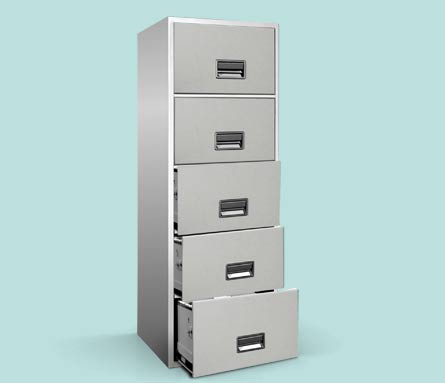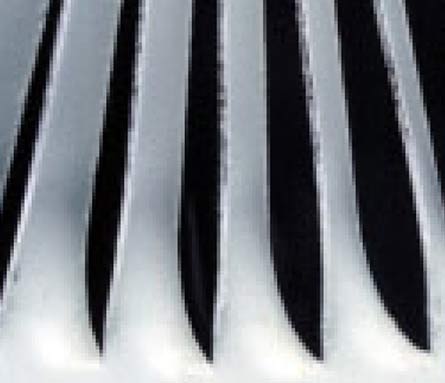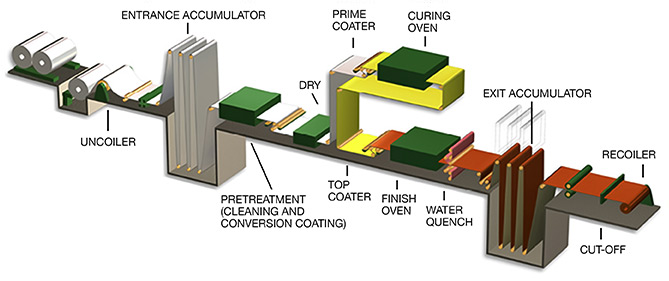
The XLM Company needed to create a finished metal product – file cabinets -- with a beautiful surface that was tough enough to resist rust even in extreme conditions. Prepain...

What if you wanted to improve an existing metal product to fight corrosion without radically altering your fabrication process? If you’re Ford New Holland, you get together w...

Even with exposed cut edges, prepainted metal outperforms post-painted parts. Yes, really. We’ve done the study to prove it. Prepainted metal louvers with exposed cut ...
Learn the fundamentals of steel, aluminum, prepaint, and the coil coating process.
Explore design options, prepainted metal attributes, and the advantages of prepainted metal in many industries.
Learn how physical tests are performed in the coil coating industry for quality assurance and performance evaluation.
Environmental
Tool Kit #28, California Prop 65 and Prepainted Metal
General
Tool Kit #7, Pigments for the Coil Coating Industry
Tool Kit #8, Coil Coating Topcoat Systems
Tool Kit #9, Coil Coating Glossary
Tool Kit #12, Frequently Asked Questions
Tool Kit #24, Service Life of Prepainted Metal
Tool Kit #25, Solar Reflective Coated Metal Roofs vs. Vegetative Roofs
Tool Kit #34, Comparison of European Coil Coating Test Methods (EN 13523) and ASTM Guides, Practices and Test Methods
Tool Kit #35, Pine Straw Build-up on Prepainted Metal Roofing
Tool Kit #36, Do AAMA Specifications Apply to the Prepainted Industry?
Tool Kit #38, Cool Roofing, and the CRRC Roofing and Wall Rating Programs
Tool Kit #42, Removing Organic Growth from Prepainted Metal Roofing Organic Growth
Tool Kit #43, Assessing Adhesion of Prepainted Metal
Quality
Tool Kit #1, Preventing Job Site Storage Corrosion of Prepainted Building Panels
Tool Kit #5, Fundamentals of Corrosion and Its Relevance to Prepainted Metal
Tool Kit #11, What Does the Term “Suitable for Coil Coating” Mean
Tool Kit #15, Demonstrations of Imperfections
Tool Kit #19, Pressure Mottling
Tool Kit #22, Assessing the Damage Resistance of a Coating
Tool Kit #26, Factors Influencing the Long-Term Performance of Pre-Painted Metal Buildings
Tool Kit #32, Color Evaluation in the Coil Coating Industry
Safety
Tool Kit #20, Securing Coils for Shipping and Related Requirements
Tool Kit #37, Personal Protective Equipment Best Practices
Why is outsourcing the best option?
In today's business environment, the ability to increase profits through increased prices is nearly impossible. Business analysts say the best way to increase profits is to outsource services or lower internal operating costs. With over 30% of the manufacturing maintenance budgets and plant capital expenditures being spent on growing environmental compliance with ever more strict EPA regulations, the need to reduce these and other operations costs is paramount to survival. Coil coating, also referred to as prepaint, is the outsourcing solution.
Who should consider prepaint?
When should a conversion to prepaint be considered?
Generally, conversions to prepaint occur when other major manufacturing changes are taking place. The time to consider a conversion is when:
Other factors for consideration include:
What does the coil coating process look like?

How does the coil coating process work?
Coil coating is a continuous and highly automated process for coating metal before fabrication. In one continuous process, a coil of metal, up to 72 inches wide moving up to 700 feet per minute, is unwound and both the top and bottom sides are cleaned, chemically treated, primed, oven cured, top coated, oven cured again, rewound and packaged for shipment.
More specifically, bare coils of metal are placed on an unwinder or decoiler where the metal is observed for defects. The metal is then cleaned and chemically treated in preparation for painting. Brushes can be used to physically remove contaminants from the sheet, or the metal may be abraded by flap sanders to further enhance the surface. Pretreatments may be used to provide the bond between the metal and the coating, in addition to making the product corrosion resistant. The type of chemical treatment varies with the type of metal being used.
After drying, the strip enters a coating room for a coat of primer usually on both sides of the sheet. The pickup roll transfers the coating liquid from the pan to the applicator roll. The liquid is then pumped into the pan, and then overflows back to the supply reservoir, where it is remixed and filtered.
The direction of the rotation of the applicator roll plays a part in determining the type of coating. Reverse roller coating, when the applicator roll turns in the opposite direction of the strip, is used to apply thick coatings. Direct roller coating, turning in the same direction as the strip, is used for thinner coatings, 0.5 mils or less.
The paint sheet then enters an oven in which the coating is cured at high temperatures for 15 to 30 seconds. The strip exits the oven and is cooled with air and water. A majority of specifications call for two coats (primer and top coat) on each side of the sheet, requiring a pass through a second coater room and oven. The fully painted sheet then exits the second oven and is cooled before inspection and rewind.
Since the process allows metals to be finished in one continuous pass, there is flexibility in how the metal is coated and the types of coatings. Organics and inorganics, such as polyesters, epoxies, vinyls, plastisols, acrylics, water-born emulsions, fluorocarbons, dry lubricants, treatment and primer combinations, can be applied. Prepainted coils can also be printed, striped and embossed to create special visual effects.
Coil coating provides for controls that are virtually impossible to attain with most other painting processes. Dealing with a flat sheet allows for mechanical cleaning in addition to the spray cleaning. The flat sheet also enables excellent control of coating weights of both the pretreatment and the paint to within a tenth of a mil or less, depending upon the equipment and the paint system being applied. Such advantages, along with the economic and environmental benefits, make coil coating the right choice for many manufacturers.
Can prepainted metal be formed?
Yes, in fact, prepainted metal can be formed and shaped with a finish that is actually superior to post-paint. This is because post-painted surfaces often suffer from dirt and oil residue, uneven application, and other imperfections. You can preclean, preprime, pretreat, and prepaint metal coils prior to manufacturing, saving cost, time, and hassles, while ensuring a beautiful and flawless surface…even after forming. Once you see how easily prepainted metal can be formed, you'll form a new opinion about this remarkable process.
How can prepainted metal be joined?
Prepainted metal can be joined easily – using adhesives, fasteners, or welding – and still retain a more beautiful and flawless surface than post-painted metal. That's because prepainted metal has a more flawless top coat to start, with paint covering edge to edge, at a consistent thickness, often with both top and bottom coats. Be assured prepainted metal can be joined beautifully.
Does prepainted metal with cut-edge weather well?
Yes, research has proven that prepainted cut-edge actually holds up better over time than post-painted surfaces, due to prepaint's overall superior surface. It may be hard to believe, but it's true: prepainted metal with cut-edges corrodes significantly less than post-painted metal with no exposed edges. So make your products a cut above the rest…by using prepaint.
The NCCA, with the help of PPG Industries, Inc. and the North American Zinc-Aluminum Coaters Association (NamZAC), compared the corrosion resistance of prepainted with three types of post-paint. Prepainted metal louvers with exposed cut edges were tested in the field along side three sets of metal louvers, one with a post-painted electrocoat, a second with a powder finish and a third with a spray finish. The parts were made of hot dipped galvanized steel, and the louvers were exposed to the same environment over time in Daytona Beach, Florida.
After 16 months, 44 months, and 68 months of exposure to the elements, comparisons showed the corrosion resistance of the prepainted parts was repeatedly and significantly better than the post-painted parts, in terms of the uniformity of treatment and film thickness.
The reason the prepainted parts outperformed post-painted ones is that prepainted metal sheet is uniformly cleaned, pretreated and painted as a flat surface, so the edge to edge and side to side variability is virtually eliminated. In addition, the prepainted part has two coats (primer and top coat), and each is tightly bonded to the metal as compared to a post-painted part, which generally has only one coat of paint. In most cases, the prepainted part has paint (one or two coats) on the backside as compared to the post-painted part which at best has a minimal amount of overspray. Uniform pretreatment and paint on the backside of a part increases the corrosion resistance of the part, enhancing long-term durability.
So when it comes to cut-edge, prepaint edges out the competition.
Can prepainted metal be handled without harming the surface?
See if you can handle this fact. Prepainted metal can be shipped on flatbed trucks, moved using forklifts, stored as coils for long periods -- and still retain a beautiful and flawless surface. Hard to believe? It's true: prepainted metal can be handled successfully, without harming the surface.
Storing prepainted coils also is a simple process. Coils should be stored in a temperature controlled warehouse. To further ensure successful job site storage, paper-wrap panel bundles, and consider using cover (waster) sheets and end caps. Of course, as an additional prevention, minimize storage time.
The contents of each bundle should be described in an external packing slip to minimize damage to paper packaging required for receipt inspection. Generic labels may also be affixed to panel bundles describing proper handling and storage practices.
Handling prepainted coils is simple…and it has beautiful results.
Can prepainting accommodate special design and aesthetic needs?
Yes, prepainted coils can be printed, striped and embossed to create special visual effects. In many ways, coil coating has limitless design possibilities, many of which are virtually impossible with post-painted metal.
Are there cost benefits to switching to prepaint?
Like most manufacturers, you're probably burdened with adapting your paint shop to changing environmental standards, stringent health regulations, and skyrocketing overhead. Outsourcing your metal treatment and coating operations can even eliminate all of these hassles and costs.
All businesses are trying to lower costs and remain competitive. Conversion to prepaint is the answer for manufacturers seeking ways to pare down unnecessary costs.
A Prepaint Conversion Team, consisting of internal and external managers and suppliers, should be established to analyze your products and process, to determine if prepaint conversion is practical. This team can also act as a steering committee once implementation begins.
After the initial analysis has determined that the use of prepaint is practical, a cost justification study should be conducted to determine the full economic impact of the proposed conversion. This analysis should answer three major questions:
Once the conversion process is complete, your plant will run more efficiently, more effectively, and more economically. Improve your product. Improve your bottom line. Coil coating is your solution.
To learn more about cost savings download our Cost Comparison Form.
To Convert Or Not to Convert?
Use this Cost Comparison Analysis to understand the long-term savings in converting to coil coated material. This form is divided into three sections - Inventory Costs, Fixed Paint Equipment Costs and Operating Costs. We recommend that you review the form with a coil coating industry representative to better understand the costs.
Reference Instructions and Definitions to Cost Comparison Analysis Form
Inventory Costs – The value of the inventory plus the financial costs of possessing and maintaining an inventory of the raw materials that...
Steel Market Development Institute Fact Sheets
Steel Market Development Institute (SMDI), a business unit of the American Iron and Steel Institute (AISI) developed facts sheets about steel as a sustainable construction material. Click to download the fact sheets: Which is the More Sustainable Building Material - Wood or Steel?
Cool Metal Roofs are Energy Efficient and Cost Effective
A series of information bulletins referred to as "GalvInfoNotes" serve as an excellent primer on the terminology and use of zinc or metallic-coated steel sheet. These bulletins are similar to "frequently-asked-questions" but with more detail.